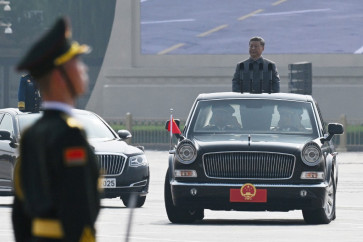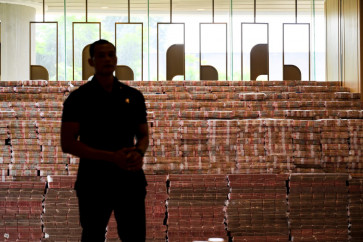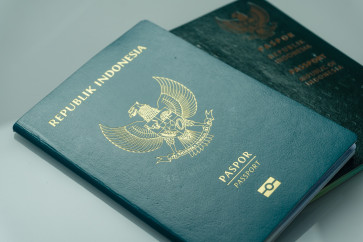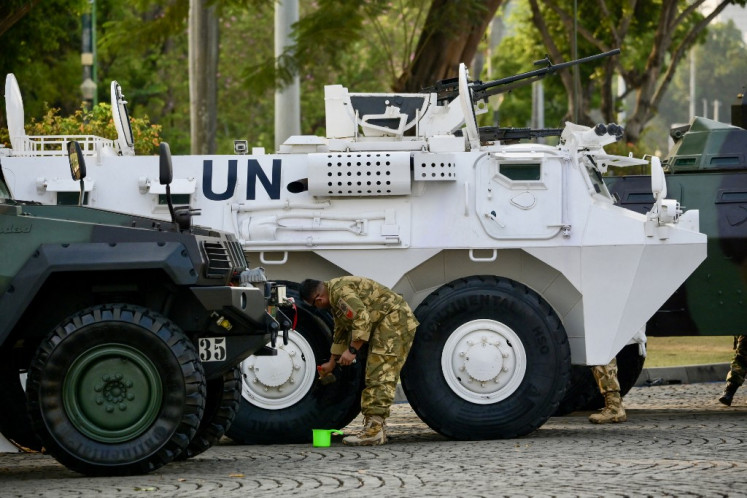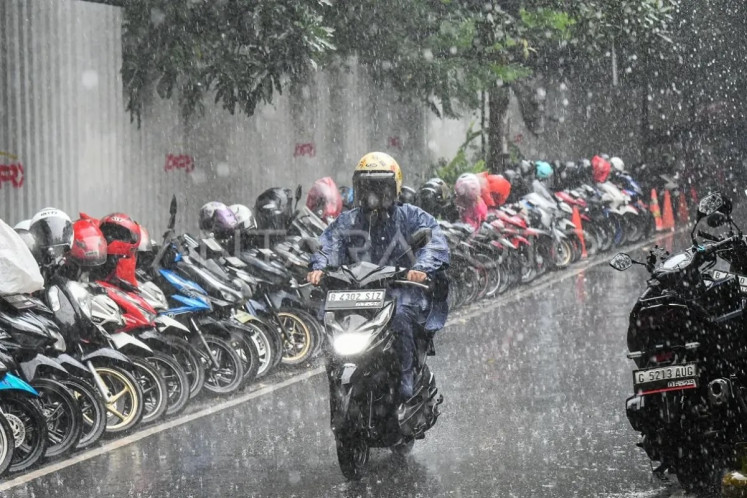Popular Reads
Top Results
Can't find what you're looking for?
View all search resultsPopular Reads
Top Results
Can't find what you're looking for?
View all search resultsRediscovering a lost Istanbul
I first met the legendary Turkish photojournalist Ara G*ler 14 years ago, in a bistro on Rue du Bac in Paris
Change text size
Gift Premium Articles
to Anyone
I
first met the legendary Turkish photojournalist Ara G*ler 14 years ago, in a bistro on Rue du Bac in Paris.
At the time, I was just commencing research on the biography of a dear friend of mine, Ratna Cartier-Bresson, the first - and Indonesian - wife of Henri Cartier-Bresson, one of the founders of the international photo agency, Magnum Photos.
G*ler, who was a member of the agency for a time, had been in a group of photographers who had contributed to a photo essay called A Day in the Life of Indonesia, published by Didier Millet.
G*ler is a craggy man who resembles a large friendly leprechaun with quick reactions and, of course, carrying the sempiternal camera. First and foremost a photojournalist, he worked for such publications as the newspaper Yeni, American magazine Time-Life, French magazine Paris Match, as well as major Turkish newspaper Hurriyet Daily News.
Yet the best of G*ler's journalistic oeuvre goes beyond documentary, indisputably crossing the boundary into the fine arts.
G*ler speaks fluent French, which helped me, as my Turkish now is almost nonexistent, just a smattering remembered from bygone years, when my Turkish-born mother and Indonesian father - who studied at Istanbul University - spoke Turkish together. I always spoke French to my Turkish relatives, or English, or even German, a m*lange of expressions and lilts (Istanbulites often speak many foreign languages because of the wide range of schools there and the very cosmopolitan nature of the historical city).
I met G*ler again last September, at the opening of "Lost Istanbul, annees 50-60", an exhibition dedicated to his photographs at La Maison Europ*enne de la Photographie in Paris.
G*ler is 81 years old now, but his memory is still sharp, obviously filled with images of that which no longer exists. Despite always denying that there is nothing to photograph in contemporary Istanbul, G*ler is interested in capturing the past before it disappears.
For me, this exhibition and the panel discussion at the opening were a revelation, a rediscovery of my own lost Istanbul, as memories came flooding back.
At the discussion, Laura Serani, the curator of the exhibition, questioned G*ler about his work. Jimmy Fox, former editor at Magnum, prodded him to tell us about the photography of the wars around Turkey.
Ayperi Karabuda Ecer, former editor-in-chief of Magnum and now vice president of pictures at Reuters, shared her memories of G*ler, whom she knew when she was a child; she assured us that she had been quite scared of him.
Also there were the French artistic director of "The Season of Turkey", a France-wide festival celebrating Turkish culture, and even "Mr. Sipa" himself - Goksin Sipahioglu, the renowned Turkish photographer who, with his American wife Phyllis Springer, founded the photo agency Sipa Press.
The exhibition featured more than 80 black and white prints of Istanbul in the 1950s and 1960s - indeed a "lost Istanbul". It was an Istanbul I had known as a child, visiting the city and my relatives with my parents, but it had been lost to me for many years because I had no images to remind me of the places I had seen.
Seeing G*ler's striking black and white visions of bygone Istanbul stirred up my remembrance of things past. It was with a child's eyes, a child's heart, that I beheld the stark prints of the Bosphorus and the Golden Horn, the streets of Pera (Bey*glu) and Tophane, the spires of the Sinan mosques and traces of the Constantinople of the past.
I see and remember the incredible traffic over Galata Bridge, my blonde cousin boldly maneuvering her small car through it, at times gesticulating both elegantly and firmly.
There were the Prince Islands that we often visited, on the European side of Turkey, the water flowing downstream between the boats, the play of huge steamers chugging down to the Black Sea, small ferries transporting passengers from continent to continent, between Asia and Europe - just tiny skiffs flitting around.
I remember the Istanbulites, those hospitable people from all sections of society, including the simple carpet seller in the Covered Market. I remember the food, simple, excellent, exquisite.
More memories. The small wooden house on the banks of the sea that my blind architect uncle lived in, where he swam in the waters unaided. Bebek, where my cousin's cousin (from her father's side) faced a small harbor with its elegant yachts.
A bit further, to the narrowest part of the Bosphorus, where a museum now stands. The hills stretch behind the bridge spanning the Golden Horn.
I peered intensely at the prints and found landmarks, both geographical and mental prints, and I recalled where buildings stood: the Topkapi Palace known by some of my ancestors - a court composer of Turkish music, my great-grandmother - and surely where Ara G*ler's grandparents swarmed.
Parallel to the exhibition at the MEP is one at the Paris Globe Galerie, which shows 25 black and white Ara G*ler prints taken in Aphrodisias, Efas, Bursa and Istanbul.
I last visited Istanbul in 1994, just six months before my mother passed away unexpectedly. I am about to travel there again, and I hope to find it as beautiful in reality as in my mind's eye.
Ah Istanbul - that unique city that hosts a synthesis of cultures, that meeting point of East and West, the crossroads, maritime intersection, gateway to Russia, Tajikistan, Turkestan.
So many peoples and cultures gathered around those shores and on those of Izmir further down the Asian coast. Greeks came and lived there, Sephardic Jews who spoke Spanish, Armenians, Janissaries, Ottoman Turks stretching into Europe from Asia.
The part of Istanbul called Bey*glu is G*ler's part. The area was formerly the French Pera district and it was there that G*ler's father, a pharmacist, raised his family.
G*ler regularly visits the cafe in Bey*glu that was named after him and where there is a gallery. His family lived in the building for a long time, and you can be almost sure of meeting him there, in what is his own living room/cafe. He moves in a band of male photographers, but respects the women who now take photos professionally, in secular Turkey.
Now in Istanbul, there are huge bridges and a project for a tunnel to connect the banks of the two continents. Large luxury hotels dot the hills around the waters of the great harbor city.
Other photographers, not least Henri Cartier-Bresson and Marc Riboud, have taken wonderful photos of contemporary Istanbul; surely, there are many great Turkish photographs to ensure a legacy for the next generation. Most of these will know of G*ler, or even seek him out as an introduction to Istanbul.
For his is, indeed, an Istanbul we see no more, the channel through which the Istanbul of the 1950s and 1960s comes back to life. Seeing these pieces of history is to observe the stark contrast between then and now, as shown in contemporary photographic takes of the great city.
And this is why, in the way Henri Cartier-Bresson was called the "eye of the *20th* century", G*ler is "the eye of Istanbul", through whose lens we see into the heart of Istanbul, and Turkey.
No wonder that Nobel Prize-winning writer Orhan Pamuk, who briefly trained as an architect, asked G*ler to help illustrate his own book about Istanbul, printed in 2007.
For while G*ler might be known as a photojournalist, his photos go beyond mere documentary. Even as I was lost in memories of my lost Istanbul, I was touched by the sheer beauty of the prints, as captured in the exhibition and in a book of the same title.
Photography has now reached the stage of being recognized as an art but this tends to be only a certain kind of photography that displays masterful images, not the journalistic style.
Certainly, G*ler's work is journalistic but of the highest kind, best shown in his black and white prints.
He had an "eye" for photography. Cartier-Bresson once told me that to have an eye for images and events was not enough - one had to work with this talent and not waste it. Photography is not just pressing down on a button of a camera, whether digital or not.


